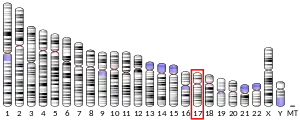| KRT9 | |||||||||||||||||||||||||||||||||||||||||||||||||||
|---|---|---|---|---|---|---|---|---|---|---|---|---|---|---|---|---|---|---|---|---|---|---|---|---|---|---|---|---|---|---|---|---|---|---|---|---|---|---|---|---|---|---|---|---|---|---|---|---|---|---|---|
| Identifiers | |||||||||||||||||||||||||||||||||||||||||||||||||||
| Aliases | KRT9, CK-9, EPPK, K9, keratin 9 | ||||||||||||||||||||||||||||||||||||||||||||||||||
| External IDs | OMIM: 607606 HomoloGene: 133554 GeneCards: KRT9 | ||||||||||||||||||||||||||||||||||||||||||||||||||
| |||||||||||||||||||||||||||||||||||||||||||||||||||
| |||||||||||||||||||||||||||||||||||||||||||||||||||
| |||||||||||||||||||||||||||||||||||||||||||||||||||
| |||||||||||||||||||||||||||||||||||||||||||||||||||
| Wikidata | |||||||||||||||||||||||||||||||||||||||||||||||||||
| |||||||||||||||||||||||||||||||||||||||||||||||||||
Keratin 9 is a protein that in humans is encoded by the KRT9 gene.[3][4]
Keratin 9 is a type I cytokeratin. It is found only in the terminally differentiated epidermis of palms and soles. Mutations in the gene encoding this protein cause epidermolytic palmoplantar keratoderma.[5]
References
- 1 2 3 GRCh38: Ensembl release 89: ENSG00000171403 - Ensembl, May 2017
- ↑ "Human PubMed Reference:". National Center for Biotechnology Information, U.S. National Library of Medicine.
- ↑ Langbein L, Heid HW, Moll I, Franke WW (December 1993). "Molecular characterization of the body site-specific human epidermal cytokeratin 9: cDNA cloning, amino acid sequence, and tissue specificity of gene expression". Differentiation. 55 (1): 57–71. doi:10.1111/j.1432-0436.1993.tb00033.x. PMID 7507869.
- ↑ Schweizer J, Bowden PE, Coulombe PA, Langbein L, Lane EB, Magin TM, Maltais L, Omary MB, Parry DA, Rogers MA, Wright MW (July 2006). "New consensus nomenclature for mammalian keratins". J. Cell Biol. 174 (2): 169–74. doi:10.1083/jcb.200603161. PMC 2064177. PMID 16831889.
- ↑ Reis A, Hennies HC, Langbein L, Digweed M, Mischke D, Drechsler M, Schröck E, Royer-Pokora B, Franke WW, Sperling K (February 1994). "Keratin 9 gene mutations in epidermolytic palmoplantar keratoderma (EPPK)". Nat. Genet. 6 (2): 174–9. doi:10.1038/ng0294-174. PMID 7512862. S2CID 31277241.
Further reading
- Stelzl U, Worm U, Lalowski M, et al. (2005). "A human protein-protein interaction network: a resource for annotating the proteome". Cell. 122 (6): 957–68. doi:10.1016/j.cell.2005.08.029. hdl:11858/00-001M-0000-0010-8592-0. PMID 16169070. S2CID 8235923.
- Kobayashi S, Tanaka T, Matsuyoshi N, Imamura S (1996). "Keratin 9 point mutation in the pedigree of epidermolytic hereditary palmoplantar keratoderma perturbs keratin intermediate filament network formation". FEBS Lett. 386 (2–3): 149–55. doi:10.1016/0014-5793(96)00393-6. hdl:2433/182271. PMID 8647270. S2CID 28388021.
- Jin J, Smith FD, Stark C, et al. (2004). "Proteomic, functional, and domain-based analysis of in vivo 14-3-3 binding proteins involved in cytoskeletal regulation and cellular organization". Curr. Biol. 14 (16): 1436–50. doi:10.1016/j.cub.2004.07.051. PMID 15324660. S2CID 2371325.
- Feng W, Han W, Man X, et al. (2008). "Identification of the keratin 9 (KRT9) N161S mutation in a Chinese kindred with epidermolytic palmoplantar keratoderma". Eur J Dermatol. 18 (4): 387–90. doi:10.1684/ejd.2008.0432 (inactive 1 August 2023). PMID 18573708.
{{cite journal}}: CS1 maint: DOI inactive as of August 2023 (link) - Kierszenbaum AL (2002). "Keratins: unraveling the coordinated construction of scaffolds in spermatogenic cells". Mol. Reprod. Dev. 61 (1): 1–2. doi:10.1002/mrd.1124. PMID 11774369. S2CID 28475473.
- Endo H, Hatamochi A, Shinkai H (1997). "A novel mutation of a leucine residue in coil 1A of keratin 9 in epidermolytic palmoplantar keratoderma". J. Invest. Dermatol. 109 (1): 113–5. doi:10.1111/1523-1747.ep12276751. PMID 9204965.
- Covello SP, Irvine AD, McKenna KE, et al. (1998). "Mutations in keratin K9 in kindreds with epidermolytic palmoplantar keratoderma and epidemiology in Northern Ireland". J. Invest. Dermatol. 111 (6): 1207–9. doi:10.1046/j.1523-1747.1998.00445.x. PMID 9856842.
- Hamada T, Ishii N, Karashima T, et al. (2005). "The common KRT9 gene mutation in a Japanese patient with epidermolytic palmoplantar keratoderma and knuckle pad-like keratoses". J. Dermatol. 32 (6): 500–2. doi:10.1111/j.1346-8138.2005.tb00789.x. PMID 16043929. S2CID 32916199.
- Barbe L, Lundberg E, Oksvold P, et al. (2008). "Toward a confocal subcellular atlas of the human proteome". Mol. Cell. Proteomics. 7 (3): 499–508. doi:10.1074/mcp.M700325-MCP200. PMID 18029348. S2CID 10810250.
- Kobayashi S, Kore-eda S, Tanaka T (1999). "Demonstration of the pathogenic effect of point mutated keratin 9 in vivo". FEBS Lett. 447 (1): 39–43. doi:10.1016/S0014-5793(99)00233-1. PMID 10218578. S2CID 44924402.
- Zhao JJ, Zhang ZH, Niu ZM, et al. (2008). "Mutation M157R of keratin 9 in a Chinese family with epidermolytic palmoplantar keratoderma". Int. J. Dermatol. 47 (6): 634–7. doi:10.1111/j.1365-4632.2008.03441.x. PMID 18477167. S2CID 21427875.
- Chen XL, Xu CM, Cai SR, et al. (2009). "Prenatal diagnosis of epidermolytic palmoplantar keratoderma caused by c.T470C (p.M157T) of the keratin 9 gene in a Chinese kindred". Prenat. Diagn. 29 (9): 911–3. doi:10.1002/pd.2315. PMID 19548225. S2CID 43229075.
- Lee JH, Ahn KS, Lee CH, et al. (2003). "Keratin 9 gene mutations in five Korean families with epidermolytic palmoplantar keratoderma". Exp. Dermatol. 12 (6): 876–81. doi:10.1111/j.0906-6705.2003.00012.x. PMID 14675368. S2CID 40628931.
- Tsunemi Y, Hattori N, Saeki H, et al. (2002). "A keratin 9 Gene mutation (Asn160Ser) in a Japanese patient with epidermolytic palmoplantar keratoderma". J. Dermatol. 29 (12): 768–72. doi:10.1111/j.1346-8138.2002.tb00220.x. PMID 12532041. S2CID 43884047.
- Strausberg RL, Feingold EA, Grouse LH, et al. (2002). "Generation and initial analysis of more than 15,000 full-length human and mouse cDNA sequences". Proc. Natl. Acad. Sci. U.S.A. 99 (26): 16899–903. Bibcode:2002PNAS...9916899M. doi:10.1073/pnas.242603899. PMC 139241. PMID 12477932.
- Li M, Yang LJ, Hua HK, et al. (2009). "Keratin-9 gene mutation in epidermolytic palmoplantar keratoderma combined with knuckle pads in a large Chinese family". Clin. Exp. Dermatol. 34 (1): 26–8. doi:10.1111/j.1365-2230.2007.02384.x. PMID 17362238. S2CID 10208101.
- Codispoti A, Colombo E, Zocchi L, et al. (2009). "Knuckle pads, in an epidermal palmoplantar keratoderma patient with Keratin 9 R163W transgrediens expression". Eur J Dermatol. 19 (2): 114–8. doi:10.1684/ejd.2008.0575. PMID 19106041.
- Frum R, Busby SA, Ramamoorthy M, et al. (2007). "HDM2-binding partners: interaction with translation elongation factor EF1alpha". J. Proteome Res. 6 (4): 1410–7. doi:10.1021/pr060584p. PMC 4626875. PMID 17373842.
- Funakushi N, Mayuzumi N, Sugimura R, Ikeda S (2009). "Epidermolytic palmoplantar keratoderma with constriction bands on bilateral fifth toes". Arch Dermatol. 145 (5): 609–10. doi:10.1001/archdermatol.2009.83. PMID 19451521.
This article is issued from Wikipedia. The text is licensed under Creative Commons - Attribution - Sharealike. Additional terms may apply for the media files.

